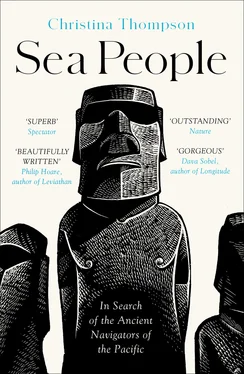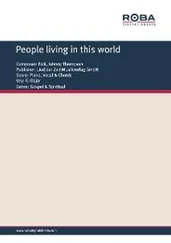1 ...6 7 8 10 11 12 ...19 The island, which was known to its inhabitants as Fatu Hiva, was the southernmost of the Marquesas, and as the Spanish approached, a fleet of about seventy canoes pulled out from shore. Quirós noted that these vessels were fitted with outriggers, a novelty he carefully described as a kind of wooden structure attached to the hull that “pressed” on the water to keep the canoe from capsizing. This was something many Europeans had not seen, but the development of the outrigger, which can be traced back as far as the second millennium B.C. in the islands of Southeast Asia, was the key innovation that made it possible for long, narrow, comparatively shallow vessels (i.e., canoes) to sail safely on the open ocean.
Each of the Marquesan canoes carried between three and ten people, and many more islanders were swimming and hanging on to the sides—altogether, thought Quirós, perhaps four hundred souls. They came, he wrote, “with much speed and fury,” paddling their canoes and pointing to the land and shouting something that sounded like “ atalut .” The anthropologist Robert C. Suggs, who did fieldwork in the Marquesas in the 1950s, thinks they were telling Mendaña to bring his ships closer inshore—“a friendly bit of advice,” as he puts it, “from one group of navigators to another.” Or maybe it was a strategy to get them to a place where they could be more effectively contained.
Quirós wrote that the islanders showed few signs of nervousness, paddling right up to the Spanish ships and offering coconuts, plantains, some kind of food rolled up in leaves (probably fermented breadfruit paste), and large joints of bamboo filled with water. “They looked at the ships, the people, and the women who had come out of the galley to see them . . . and laughed at the sight.” One of the men was persuaded to come aboard, and Mendaña dressed him in a shirt and hat, which greatly amused the others, who laughed and called out to their friends. After this, about forty more islanders clambered aboard and began to walk about the ship “with great boldness, taking hold of whatever was near them, and many of them tried the arms of the soldiers, touched them in several parts with their fingers, looked at their beards and faces.” They appeared confused by the Europeans’ clothing until some of the soldiers let down their stockings and tucked up their sleeves to show the color of their skin, after which, Quirós wrote, they “quieted down, and were much pleased.”
Mendaña and some of his officers handed out shirts and hats and trinkets, which the Marquesans took and slung round their necks. They continued to sing and call out, and as their confidence increased, so did their boisterousness. This, in turn, annoyed the Spanish, who began gesturing for them to leave, but the islanders had no intention of leaving. Instead they grew bolder, picking up whatever they saw on deck, even using their bamboo knives to cut slices from a slab of the crew’s bacon. Finally, Mendaña ordered a gun to be fired, at which the islanders all leapt into the sea—all except one, a young man who remained clinging to the gunwale, refusing, either out of obstinance or terror, to let go until one of the Spaniards cut him with a sword.
At this, the tenor of the encounter changed. An old man with a long beard stood up in his canoe and cried out, casting fierce glances in the direction of the ships. Others sounded their shell trumpets and beat with their paddles on the sides of their canoes. Some picked up their spears and shook them at the Spaniards, or fitted their slings with stones and began hurling them at the ship. The Spaniards aimed their arquebuses at the islanders, but the powder was damp and would not light. “It was a sight to behold,” wrote Quirós, “how the natives came on with noise and shouts.” At last, the Spanish soldiers managed to fire their guns, hitting a dozen or so of the islanders, including the old man, who was shot through the forehead and killed. When they saw this, the islanders immediately turned and fled back to shore. A little while later, a single canoe carrying three men returned to the ships. One man held out a green branch and addressed the Spaniards at some length; to Quirós he seemed to be seeking peace. The Spanish made no response, and after a little while the islanders departed, leaving some coconuts behind.
THE ENCOUNTERS BETWEEN the Marquesans and Mendaña’s people were filled with confusion, and many “evil things,” wrote Quirós, happened that “might have been avoided if there had been someone to make us understand each other.” In this, it was like many early encounters between Europeans and Polynesians: everything that happened made sense to someone, but much of it was baffling, offensive, or even deadly to those on the other side.
In one incident, four “very daring” Marquesans made off with one of the ships’ dogs; in another, a Spanish soldier fired into a crowd of canoes, aiming at and killing a man with a small child. On shore, Mendaña ordered a Catholic mass to be held, at which the islanders knelt in imitation of the strangers. Two Marquesans were taught to make the sign of the cross and to say “Jesus, Maria”; maize was sown in the hope that it might take. Mendaña’s wife, Doña Isabel, tried to cut a few locks from the head of a woman with especially beautiful hair but was forced to desist when the woman objected—the head, being tapu , should not have been touched, as hair was known to be useful for sorcery.
Three islanders were shot and their bodies hung up so that the Marquesans “might know what the Spaniards could do.” Mendaña envisioned establishing a colony, leaving behind thirty men along with some of their wives. But the soldiers adamantly refused this mission. Perhaps they understood, no doubt correctly, that it would have been more than their lives were worth, for by the time the Spanish finally departed, they had killed more than two hundred people, many, according to Quirós, for no reason at all.
Quirós was distressed by the cruel and wanton behavior of Mendaña’s men. In the islanders, on the other hand, he found much to admire. Indeed, it is through Quirós’s eyes that we get our first glimpse of a people who would come to epitomize for many Europeans the pinnacle of human beauty. One later visitor described the Marquesans as “exquisite beyond description” and the “most beautiful people” he had ever seen. Even Cook, a man never given to exaggeration, called them “as fine a race of people as any in this Sea or perhaps any whatever.”
The islanders, wrote Quirós, were graceful and well formed, with good legs, long fingers, and beautiful eyes and teeth. Their skin was clear and “almost white,” and they wore their hair long and loose “like that of women.” Many were naked when he first saw them—they were swimming at the time—and their faces and bodies were decorated with what Quirós at first took to be a kind of blue paint. This, of course, was tattooing, a practice common across Polynesia—the English word “tattoo” is derived from the Polynesian tatau —but carried to the peak of perfection in the Marquesas, where every inch of the body, including the eyelids, tongue, palms of the hands, even the insides of the nostrils, might be inscribed. Quirós found the Marquesan women, with their fine eyes, small waists, and beautiful hands, even more lovely “than the ladies of Lima, who are famed for their beauty,” and characterized the men as tall, handsome, and strong. Some were so large that they made the Spaniards look diminutive by comparison, and one made a great impression on the visitors by lifting a calf up by the ear.
Ethnographically speaking—remembering that this is the earliest recorded description of any Polynesian society that we have—Quirós’s account is slim but interesting. The Marquesans, he wrote, had pigs and chickens (“fowls of Castille”), as well as plantains, coconuts, calabashes, nuts, and something the Europeans had never seen, which they described as a green fruit about the size of a boy’s head. This was breadfruit, a plant that would enter Pacific legend two centuries later as the cargo carried by Captain William Bligh of the Bounty when his crew mutinied off the island of Tofua. (Bligh was carrying the breadfruit seedlings to the West Indies, where, it was envisioned, they would provide an economical means of feeding African slaves.) They lived in large communal houses with platforms and terraces of neatly fitted stone and worshipped what the Spanish referred to as an “oracle,” an enclosure containing carved wooden figures to whom they made offerings of food. Their tools were made of stone and shell; their primary weapons were spears and slings. Their most significant manufactures were canoes, which they made in a variety of sizes: small ones with outriggers for three to ten paddlers, and large ones, “very long and well-made,” with room for thirty or more. Of the latter wrote Quirós, “They gave us to understand, when they were asked, that they went in these large canoes to other lands.”
Читать дальше












